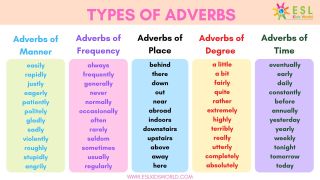Discussion:The adverbs
 Traduction
Traduction
 Définition
Définition
Domaine, Discipline, Thématique
Définition écrite
- An adverb is a word that provides information about other words in a sentence. It works to clarify and add details about how, what, where, or when something occurs. Adverbs are key in English because they make it easier for people to understand what you’re saying.
|
An adverb is a word that provides additional information about verbs, adjectives, other adverbs, or entire sentences. It clarifies and adds details about how, when, where, or to what extent something occurs. Adverbs are essential in English because they enhance the meaning and clarity of sentences.
Adverbs can be classified based on their function in a sentence: 1/Adverbs of Time: Indicate when an action occurs. Examples: yesterday, today, soon, now, later. 2/Adverbs of Place: Indicate where an action occurs. Examples: here, there, everywhere, nowhere, outside. 3/Adverbs of Manner: Describe how an action occurs. Examples: quickly, slowly, carefully, beautifully. 4/Adverbs of Frequency: Indicate how often an action occurs. Examples: always, never, often, rarely, sometimes. 5/Adverbs of Degree: Indicate the intensity or degree of an action, adjective, or another adverb. Examples: very, quite, almost, too, enough. 6/Adverbs of Purpose: Explain why an action occurs. Examples: to, in order to, so that.
Adverbs can also be categorized based on their form: 1/Simple Adverbs: Basic adverbs that do not change form. Examples: soon, well, fast. 2/Compound Adverbs: Formed by combining two words. Examples: somewhere, nowhere, everywhere. 3/Relative Adverbs: Introduce relative clauses. Examples: where, when, why. 4/Interrogative Adverbs: Used to ask questions. Examples: how, when, where, why.
Adverbs can be further classified based on their syntactic roles: 1/Sentence Adverbs: Modify the entire sentence, often expressing the speaker's attitude. Examples: fortunately, unfortunately, frankly, honestly. 2/Conjunctive Adverbs: Connect clauses or sentences, showing the relationship between them. Examples: however, therefore, moreover, consequently. 3/Focusing Adverbs: Emphasize a particular part of the sentence. Examples: only, just, even, also. ==> Understanding these classifications, categories, and typologies can help you use adverbs more effectively and accurately in your writing and speech. |
Définition graphique
- AUTRES MEDIAS
![]() The adverbs (Discipline)
The adverbs (Discipline)
![]() The adverbs: (Discipline)
The adverbs: (Discipline)
![]() The adverbs: (Discipline)
The adverbs: (Discipline)
![]() The adverbs: (Discipline)
The adverbs: (Discipline)
![]() The adverbs: (Discipline)
The adverbs: (Discipline)
![]() The adverbs
The adverbs
![]() The adverbs
The adverbs
![]() Représentation graphique spatiale The adverbs: carte conceptuelle (cmap)
Représentation graphique spatiale The adverbs: carte conceptuelle (cmap)
![]() Document PDF The adverbs: Document PDF
Document PDF The adverbs: Document PDF
![]() Image/Figure The adverbs: Titre de l'image ou de la figure
Image/Figure The adverbs: Titre de l'image ou de la figure
 Concepts ou notions associés
Concepts ou notions associés
 Exemples, applications, utilisations
Exemples, applications, utilisations
|
Time: Yesterday, I went to the park. Place: The cat is hiding underneath the table. Manner: He sings beautifully. Frequency: I always brush my teeth before bed. Degree: The water is extremely cold. Purpose: He studied hard to pass the exam. |
 Erreurs ou confusions éventuelles
Erreurs ou confusions éventuelles
![]() Exemples de difficultés de compréhension ou d'interprétation courantes:
Exemples de difficultés de compréhension ou d'interprétation courantes:
- .Placement: Adverbs can appear in various positions within a sentence (beginning, middle, or end), which can confuse learners about their correct placement.
- Similar Forms: Some adverbs have the same form as adjectives (e.g., "fast" can be both an adjective and an adverb), leading to confusion about their usage
![]() Confusions ou glissement de sens potentiels
Confusions ou glissement de sens potentiels
- Confusion entre Adverbs - Adjectives
- .Using Double Negatives: Using two negative adverbs in a sentence can create confusion.
Incorrect: I don't need no help.
- Overusing Adverbs: Using too many adverbs can make writing seem cluttered and less impactful.
Incorrect: She quickly and quietly and carefully opened the door.
 Questions possibles
Questions possibles
- What is an adverb, and how does it differ from an adjective?
- How can adverbs modify verbs, adjectives, and other adverbs?
- What are the different types of adverbs, and how are they used in sentences?
- How do adverbs of frequency (e.g., always, never, sometimes) affect the meaning of a sentence?
- How can the placement of an adverb within a sentence change its meaning?
 Liaisons enseignements et programmes
Liaisons enseignements et programmes
Idées ou Réflexions liées à son enseignement
- Contextual Learning: Adverbs are best understood in context. Use real-life examples and sentences to show how adverbs modify verbs, adjectives, and other adverbs. Encourage students to create their own sentences using adverbs in different contexts.
* Interactive Activities: Engage students with interactive activities such as adverb charades, where they act out actions described by adverbs, or adverb scavenger hunts, where they find adverbs in texts. * Comparative and Superlative Forms: Teach the comparative and superlative forms of adverbs through examples and practice exercises. Highlight irregular forms and provide plenty of practice opportunities.
- Sentence Placement: Emphasize the flexibility of adverb placement within sentences. Provide exercises where students rearrange sentences to see how adverb placement can change meaning or emphasis.
 Bibliographie
Bibliographie
Pour citer cette page: (adverbs)
ABROUGUI, M & al, 2025. Discussion:The adverbs. In Didaquest [en ligne]. <http:www.didaquest.org/wiki/Discussion:The_adverbs>, consulté le 20, mai, 2025
- Adverb Licensing and Clause Structure in English by Dagmar Haumann
- Haplology in English Adverb-Formation by Amanda V. Pounder
- Adverbs by Hans Frede Nielsen and Erik W. Hansen





